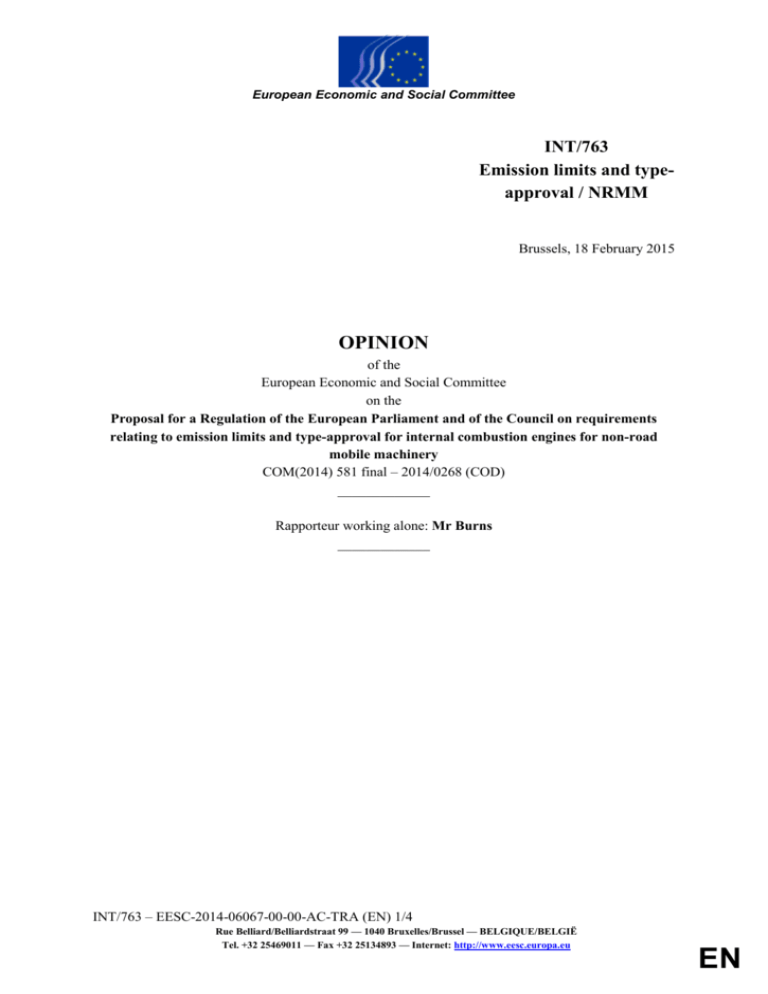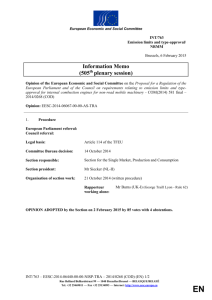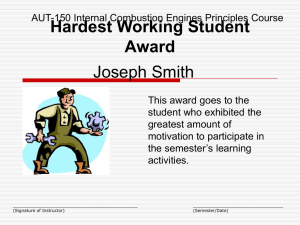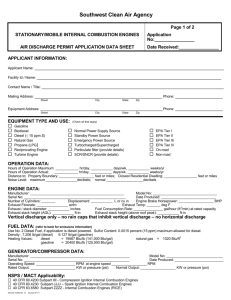Emission limits and type
advertisement

European Economic and Social Committee INT/763 Emission limits and typeapproval / NRMM Brussels, 18 February 2015 OPINION of the European Economic and Social Committee on the Proposal for a Regulation of the European Parliament and of the Council on requirements relating to emission limits and type-approval for internal combustion engines for non-road mobile machinery COM(2014) 581 final – 2014/0268 (COD) _____________ Rapporteur working alone: Mr Burns _____________ INT/763 – EESC-2014-06067-00-00-AC-TRA (EN) 1/4 Rue Belliard/Belliardstraat 99 — 1040 Bruxelles/Brussel — BELGIQUE/BELGIË Tel. +32 25469011 — Fax +32 25134893 — Internet: http://www.eesc.europa.eu EN On 19 February 2015 and 12 November 2014 respectively, the Council and the European Parliament decided to consult the European Economic and Social Committee, under Article 114 of the Treaty on the Functioning of the European Union, on the Proposal for a Regulation of the European Parliament and of the Council on requirements relating to emission limits and type-approval for internal combustion engines for non-road mobile machinery COM(2014) 581 final – 2014/0268 (COD). The Section for the Single Market, Production and Consumption, which was responsible for preparing the Committee's work on the subject, adopted its opinion on 2 February 2015. At its 505th plenary session, held on 18 and 19 February 2015 (meeting of 18 February), the European Economic and Social Committee adopted the following opinion by 164 votes to one with three abstentions. * * * 1. Recommendations 1.1 Due to the fact that the introduction of testing equipment and the development of testing procedures for the "in-service emission performance of engines" is a new concept for nonroad mobile machinery (NRMM), the EESC recommends that thorough pilot programmes be carried out for all types of engines and machinery to verify whether it is possible to install the necessary instruments. These studies should also look into whether the engine used in the machinery should be tested on a test bench, if the challenges of measuring directly on the machinery prove to be excessive. 1.2 Given the strong public health concerns about nanoparticles resulting from combustion processes and the high level of protection that can be achieved by implementing the proposed Stage V for NRMM engines, and considering the consensus on the Commission proposal expressed by many stakeholders including the engine and machinery manufacturing industry, the EESC recommends that the new regulation be approved rapidly. Thanks to intensive interaction during the drafting stage with all parties involved (including industry and NGOs), the Commission proposal recognises the different technologies available for emissions control depending on engine size and combustion cycle. INT/763 – EESC-2014-06067-00-00-AC-TRA (EN) 2/4 2. Basic principle of concept 2.1 The European Economic and Social Committee (EESC) believes that reducing harmful emissions of carbon monoxide, nitrogen oxides, hydrocarbons and particulates from engines intended for agricultural and forestry tractors is a vital step towards achieving the EU's air quality targets. 2.2 The EESC also believes that any proposed legislation aiming to benefit human health and the environment must be founded on robust technical, economic and practical proposals. 3. Background 3.1 The definition of NRMM includes a vast number of different types of machinery and combustion engines. These engines are installed in both handheld equipment, wheeled and track based machines. They operate in construction, agriculture, mining, railways, inland waterway and many other industries. The emissions limits for these engines are currently set out in Directive 97/68/EC. New emission stages were last introduced when the Directive was amended in 2004. The conclusion by the European Commission is that these no longer reflect the current state of technology and therefore NRMM can be brought into line with emissions limits used for road vehicles (e.g. busses and lorries/trucks). 3.2 However, substantial development work and resources will be required for adaptation of onroad technology to NRMM engines and machines. Because of this, the EU Commission proposal sets Euro VI limits for cases where the technology is already mature and elsewhere suggests applying the EPA limits which are already in use in American legislation which has made considerable progress in this sector. 3.3 Unlike on-highway emission regulations where there is a distinction made between the regulation of the smallest and largest vehicles, with separate legislation for motor cycles, light duty and heavy duty vehicles, the proposed non-road regulations are a blanket proposal and will include a huge range of machinery and equipment with engine power from less than 8 kW to around 3 500kW. This will include all engine cylinder capacity ranging from a fraction of a litre to more than 100 litres per cylinder. 3.4 NRMM engines operate under different circumstances to engines installed in road going vehicles. Most NRMM machines do not operate like a lorry where there is a delayed period of time between standstill to when maximum power is reached. NRMM machines mostly operate from start to immediately requiring maximum power, then a short stationary period, then max power, then stop. The cycle is then repeated. These are the normal working conditions of most NRMM machinery. This differs from the near constant levels of engine revs and power output of road going vehicles. INT/763 – EESC-2014-06067-00-00-AC-TRA (EN) 3/4 3.5 The following issues need to be considered during any adaptation process for NRMM engines: design changes to withstand the appropriate non-road conditions, including long term exposure to more aggressive environments, high shock loading and vibration compared with road vehicles used on straight, level highways; physical shape and size reconfiguration that would be required to fit within dimensional space of the variety of non-road machines and the requirement to minimise overall size of after-treatment systems; wide variety of work/load cycles over which after-treatment systems must work effectively, including rapid transient loading; ensuring appropriate thermal and chemical balances in the exhaust system for effective after-treatment system operation including regeneration of particle filter systems under a wide range of conditions; re-optimisation of engine and after-treatment system to ensure acceptable transient response and minimise fuel and reagent consumption. 4. Problems 4.1 Within the Commission’s recommendations it states that "in-service emission performance of engines" will be monitored and "pilot programmes are proposed with a view to developing appropriate testing procedures". It is important to verify the feasibility of installing portable emission measurement systems (PEMS) on a number of machines that engine manufacturers will select as representative of the use of their products. Permanent installation on all machines is not considered in this legislation. 4.2 The Stage V introduction schedule set out in the EU Commission proposal will only be possible if the legislation is adopted in a timely manner. Should there be any meaningful delay in the decision process, there will be no time to finalise product development and to carry out all type approvals. Brussels, 18 February 2015. The President of the European Economic and Social Committee Henri Malosse _____________ INT/763 – EESC-2014-06067-00-00-AC-TRA (EN) 4/4









